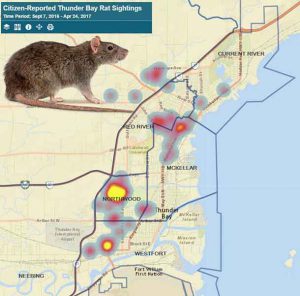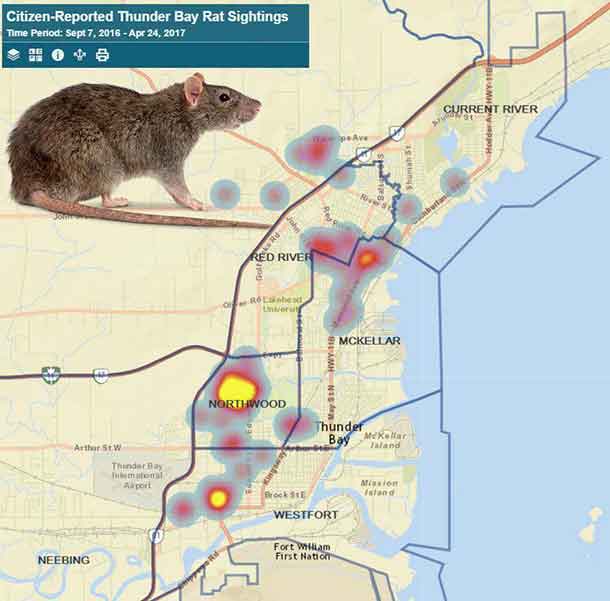
THUNDER BAY – Rats! Thunder Bay is experiencing a growing problem with Norway Rats. While there have always been rats in the city, in the past they were more concentrated near the grain elevators at the waterfront. However in recent months, residents across the city have been reporting these pests in areas across the city.
The hotbed for Norway Rats in the city appears to be in the Northwood Ward. There have been reports of Norway Rats, some the size of small cats in Northwood and around the Limbrick neighbourhood since last summer.
Why are Norway Rats a Problem?
Norway rats are one of the most destructive creatures known to man. They destroy and contaminate untold quantities of food, and through their tunneling activities, undermine the foundations of buildings, sewer and water lines, and city streets.
Rats also weaken and deface buildings by gnawing holes through floors, walls, insulation and supporting structures. Norway rats carried the flea that spread plague throughout Europe and Asia. Even today, they spread organisms responsible for food poisoning, hepatitis, tularemea and other diseases.
The Norway Rat is a brown or grey rodent with a body up to 25 cm (10 in) long, and a similar tail length; the male weighs on average 350 g (12 oz) and the female 250 g (9 oz).
The female rate can under most conditions breed four times per year with a litter of rats of up to 14 but smaller sized litters of seven rats is more common.
Left alone a population of Norway Rats will rapidly multiply.
What other problems are created by Rats?
Residents of Baltimore’s low-income neighborhoods who believe rats are a big problem where they live are significantly more likely to suffer from depressive symptoms such as sadness and anxiety, according to research from the Johns Hopkins Bloomberg School of Public Health.
Those same residents with rodent problems on their block are also plagued by other pressing urban issues such as vacant housing, drug sales on the street, and the risk of being robbed and beaten up. The study found that the relationship between rats and depression is not explained by these other neighborhood conditions.
“Nobody likes living around rats,” said study leader Danielle German, PhD, an assistant professor in the Department of Health, Behavior and Society at the Bloomberg School. “This study provides very strong evidence that rats are an underappreciated stressor that affects how people feel about their lives in low-income neighborhoods. The good news is it’s modifiable. If we can do something to reduce the number of rats in these neighborhoods, we can improve people’s well-being.”
Every time researchers would talk to residents of low-income neighborhoods about the troubling public health issues they face, German says, they expected to hear about drugs and HIV and access to healthy food. Time and again, she says, they heard about rats and trash. Many cities conduct a regular rat census or survey residents about urban conditions, but this is one of the first studies to examine the psychological toll of an entrenched rat population.
“Those who live in areas where the perceived rat problem is the greatest are more pessimistic about their own ability to control rats, have less confidence in their neighbors’ commitment to rat eradication and have relatively little faith that the city would act if called upon to address the rat problem,” German says. “Yes, eradicating rats from Baltimore City is a hard goal, but making it so no neighborhood has to see rats every day is a goal we can strive for. It would go a long way toward improving the outlook of people who live in poor neighborhoods and may be a starting point for conversations about other community health priorities. These data suggest that we need to work together with community members to achieve these goals.”
What can be done about reducing rats?
The province of Alberta has a “Rat Patrol” and spends countless hours ensuring that Alberta remains a “Rat Free” zone. One of the goals is in keeping the rat population down so that out of control population explosions won’t happen.
The Thunder Bay District Health Unit also offers this advice:
1. Eliminate food sources. This includes bird feeders, garbage, and vegetable gardens. Compost bins should be rat-proof. Rats will even eat dog feces, so clean it up. Store garbage in bins with tight-fitting lids.
2. Eliminate harbourage. This means sealing up cracks and burrows in and under outbuildings, cleaning up brush and wood piles, and removing hiding places.
3. Set rat traps yourself or hire a licensed pest control company to do it for you. Rats are vicious, so take care when trapping.
Many people like to feed birds but keep in mind this is also a major draw for rats. If you must feed the birds, do a Google for tips on how to keep rodents out of your feeder. Examples include weight-sensitive feeders and hanging baffled feeders. Also, use low-mess feed and feeders to keep food off the ground. Remember: once the food falls on the ground, your feeder is no longer a bird feeder… it is a rat feeder!


